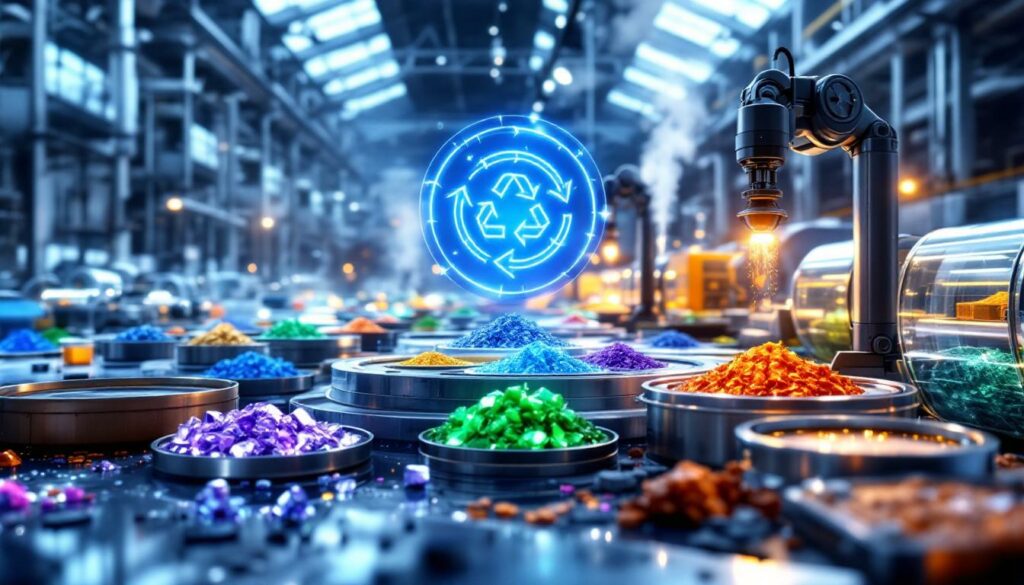The Evolution of Lithium Battery Recycling: Trends and Developments
As the world shifts toward electrification, the recycling of lithium batteries has emerged as a critical component of sustainable energy infrastructure. With millions of electric vehicles and energy storage systems now in use globally, developing efficient recycling systems has become not just an environmental necessity but an economic opportunity.
What is Driving the Growth in Lithium Battery Recycling?
The Rising Need for Sustainable Battery Solutions
The exponential growth of electric vehicles and energy storage systems has created unprecedented demand for lithium-ion batteries. According to industry projections, global lithium-ion battery demand is expected to increase tenfold by 2030, creating an urgent need for effective recycling solutions.
Environmental concerns are at the forefront of this push toward circular battery systems. Without proper recycling, valuable resources are lost, and potentially hazardous materials may enter the environment. This reality has prompted governments worldwide to develop increasingly stringent regulations regarding battery end-of-life management.
As evidenced by major investments in China, the industry is recognizing the necessity of large-scale solutions. The 50,000-metric ton Chinese battery recycling breakthrough in Chongqing's Qijiang District represents just one example of the substantial infrastructure being developed to address this challenge.
Economic Incentives for Battery Recycling
The economic case for the recycling of lithium batteries has strengthened considerably in recent years. Modern batteries contain significant quantities of valuable materials including cobalt, nickel, lithium, and manganese—materials that are becoming increasingly expensive due to supply constraints and geopolitical factors.
Recovery of these critical minerals creates substantial economic opportunities. The Chongqing recycling project alone is designed to produce 3,336 tons of lithium carbonate, 1,954 tons of manganese sulfate, 2,157 tons of cobalt sulfate, and 5,052 tons of nickel sulfate annually—all valuable precursor materials for new battery production.
Beyond material recovery, recycling helps reduce dependency on primary mining operations, stabilizing supply chains and reducing price volatility. As recycling technologies improve and economies of scale are achieved, recycled materials are becoming increasingly competitive with virgin materials on both price and quality.
How Does the Lithium Battery Recycling Process Work?
Collection and Sorting Mechanisms
The first challenge in battery recycling is establishing effective collection networks. These networks vary significantly between consumer electronics, EV batteries, and industrial applications, each requiring specialized approaches to accumulation and transport.
Once collected, batteries must be sorted by chemistry type, as different battery compositions require different recycling approaches. Modern facilities are increasingly employing automated sorting technologies that can identify battery types through visual recognition systems, barcode scanning, or spectroscopic analysis.
Safety remains a paramount concern throughout this process. The Madianhe Base in Guangdong Province has implemented what they describe as a "safety production platform with independent intellectual property rights" to mitigate risks associated with handling potentially damaged or degraded batteries.
Physical Processing Techniques
After sorting, batteries typically undergo mechanical processing. This often begins with discharge to prevent short circuits and thermal events, followed by mechanical shredding and crushing to break down battery components into manageable fractions.
The 15,000-metric ton scrap lithium battery dismantling facility in Meizhou, Guangdong Province, focuses exclusively on "physical crushing and sorting methods," according to Shanghai Metal Market (SMM) reporting. This approach separates materials based on their physical properties without chemical processes.
Separation technologies employed at this stage include magnetic separation for ferrous metals, eddy current separation for non-ferrous metals, and density-based sorting for plastics and other components. Increasingly, facilities are incorporating automated robotic systems to improve efficiency and worker safety.
Chemical Recovery Methods
Following physical separation, chemical processes are often employed to recover high-value metals. Hydrometallurgical approaches use acid leaching to selectively dissolve target metals, followed by separation and purification steps to produce battery-grade materials.
Alternative pyrometallurgical approaches utilize high-temperature treatment to recover metals, though these processes typically consume more energy and may result in lower lithium recovery rates.
The most advanced recycling operations, like the Chongqing facility, combine multiple approaches to maximize material recovery. This project is designed to produce battery-grade lithium refinery suitable for direct reuse in battery manufacturing, creating a closed-loop system for critical materials.
Emerging biological extraction techniques using specialized microorganisms show promise for more environmentally friendly processing, though these technologies remain largely in the research phase and aren't yet represented in major commercial facilities.
What Major Projects Are Advancing Battery Recycling?
Large-Scale Recycling Facilities Under Development
China has emerged as a leader in battery recycling infrastructure, with numerous large-scale projects recently announced or under construction. The 50,000-metric ton lithium battery recycling project in Chongqing's Qijiang District stands out for its comprehensive approach to handling both ternary (NMC/NCA) and lithium iron phosphate (LFP) batteries.
In Guangdong Province, twin 15,000-metric ton scrap lithium battery dismantling facilities are being developed in Meizhou and Xingning, representing a combined investment of 260 million yuan. These facilities focus on physical processing methods as the first stage of a more comprehensive recycling approach.
Anhui Province hosts a 40,000-metric ton retired power battery second-life application project developed by Guolan New Energy, with an investment of 120 million yuan. This project takes a different approach, focusing on repurposing batteries for energy storage applications rather than immediate material recovery.
Innovative Processing Technologies
Technological innovation is driving efficiency improvements throughout the recycling process. The Madianhe Circular Industry Base in Maoming, Guangdong represents a 1.7 billion yuan investment in advanced recycling technologies, including automated robotic transfer systems and intelligent processing methods.
These facilities are implementing green closed-loop systems with proprietary safety production platforms to minimize environmental impact while maximizing recovery rates. The transition toward automated systems reduces human exposure to potentially hazardous materials while improving sorting accuracy and processing speed.
In Qinghai Province, Haiding Materials Technology is developing an 80,000-metric ton hazardous waste comprehensive utilization project that will recover valuable materials including 3,108 tons of industrial-grade lithium carbonate and 26,214 tons of graphite powder annually, demonstrating the diverse outputs possible from comprehensive recycling operations.
Integration with Battery Manufacturing
A notable trend is the vertical integration of recycling operations with new battery production. Hubei Ruipai New Energy Materials is constructing a 25,000-metric ton per year LFP cathode material production line in Phase I of their project, directly connecting recycling with material manufacturing.
Co-location of recycling facilities with battery manufacturing reduces transportation costs and environmental impact while ensuring a steady supply of recycled materials. Jianli Chemical Technology exemplifies this approach with their integrated facility producing 20,000 tons of lithium hexafluorophosphate (LiPF₆) electrolyte annually in Phase I.
Forward-thinking manufacturers are also developing design-for-recycling approaches in new battery technologies, making future batteries easier to dismantle and recycle. These designs incorporate easily separable components, standardized connectors, and materials selected for recyclability.
What Materials Can Be Recovered from Recycled Batteries?
Critical Metals Recovery Rates
Modern recycling facilities focus primarily on extracting high-value metals from used batteries. The Chongqing project demonstrates the potential, recovering 3,336 tons of lithium carbonate, 2,157 tons of cobalt sulfate, and 5,052 tons of nickel sulfate annually from 50,000 tons of processed batteries.
These recovered materials meet battery-grade specifications, allowing them to be directly reincorporated into new battery production. This Panasonic closed-loop recycling approach reduces dependency on newly mined resources while maintaining performance standards.
Recovery rates continue to improve with technological advancements. While early recycling processes achieved less than 50% lithium recovery, newer hydrometallurgical approaches can recover more than 90% of lithium content, along with similar high recovery rates for cobalt and nickel.
Secondary Materials and By-products
Beyond primary battery metals, recycling operations recover numerous secondary materials. The Qinghai Haiding project, for example, produces 26,214 tons of graphite powder annually—a valuable material for both battery production and other industrial applications.
Chemical by-products represent another valuable output stream. The same Qinghai facility recovers 30,840 tons of regenerated electrolyte, 8,934 tons of sodium chloride, and 2,084 tons of magnesium fluoride, all of which have commercial value in various industries.
Structural components like steel and aluminum casings are readily recycled through conventional metal recycling channels. The Qinghai project recovers approximately 8,000 tons of steel bars annually, demonstrating how comprehensive recycling operations extend beyond battery-specific materials.
Material Quality Considerations
For recycled materials to be viable in battery manufacturing, they must meet stringent purity requirements. Battery-grade lithium carbonate, for example, typically requires 99.5% purity or higher, with strict limits on specific impurities that could impact battery performance.
Testing and certification processes for recycled materials have become increasingly sophisticated, with techniques like inductively coupled plasma mass spectrometry (ICP-MS) used to verify metal content and identify trace contaminants.
Comparative studies between virgin and recycled materials have found that properly processed recycled materials can perform equivalently to virgin materials in battery applications, though consistent quality control remains essential to maintain manufacturer confidence.
What Are the Regional Developments in Battery Recycling?
Chinese Leadership in Recycling Infrastructure
China has established clear leadership in battery recycling infrastructure, with rapid expansion of recycling capacity across multiple provinces. The projects highlighted by SMM demonstrate substantial investments in Guangdong, Anhui, Qinghai, Hubei, and Chongqing provinces, creating a nationwide network of recycling capabilities.
This expansion is closely integrated with China's broader battery supply chain, which includes the world's largest battery manufacturing capacity. By developing recycling facilities alongside production, China is creating a comprehensive circular economy for battery materials.
Government support and policy frameworks have been instrumental in encouraging investment. China's Ministry of Industry and Information Technology (MIIT) has established targets for battery recycling rates and provided both regulatory guidance and financial incentives for recycling projects.
Emerging Recycling Hubs
Specialized industrial parks dedicated to battery recycling and reuse are emerging as centers of innovation. The Madianhe Circular Industry Base represents a 1.7 billion yuan investment in creating an integrated recycling ecosystem, leveraging economies of scale and shared infrastructure.
These facilities are strategically positioned near battery manufacturing centers to minimize transportation costs and environmental impact. The concentration of expertise and resources in these hubs accelerates technological development and implementation of best practices.
Cross-regional collaboration is optimizing collection and processing networks, with batteries from multiple provinces often directed to centralized processing facilities. This approach allows for greater efficiency and higher recovery rates through specialized, large-scale operations.
International Cooperation and Standards
While the projects highlighted focus on China's domestic developments, the global nature of the battery supply chain necessitates international cooperation. The development of global best practices for the recycling of lithium batteries is increasingly important as the industry matures.
Cross-border material flows present both opportunities and challenges, with regulatory frameworks often struggling to keep pace with technological developments. International standards organizations are working to harmonize approaches to battery labeling, safety protocols, and material recovery targets.
Technology transfer between developed and emerging markets is accelerating the global adoption of effective recycling practices. Chinese expertise in large-scale recycling operations offers valuable lessons for regions still developing their battery recycling infrastructure.
How Does Second-Life Application Compare to Direct Recycling?
Battery Repurposing Opportunities
Second-life applications offer an alternative to immediate recycling for batteries that no longer meet the demanding requirements of electric vehicles but retain substantial capacity. The 40,000-metric ton retired power battery second-life application project in Anhui Province demonstrates significant investment in this approach.
These repurposed batteries can serve effectively in less demanding applications like stationary energy storage, where energy density requirements are lower and occasional performance variations are more tolerable. Testing and certification processes for second-life batteries focus on evaluating remaining capacity, internal resistance, and safety parameters.
Economic models comparing direct recycling versus repurposing generally find that repurposing creates higher immediate value from used batteries, though recycling may ultimately recover more value over the complete lifecycle. The optimal approach often depends on battery chemistry, age, and market conditions.
Technical Challenges in Battery Reuse
Battery health assessment remains a significant technical challenge for second-life applications. Accurately predicting remaining useful life requires sophisticated diagnostic techniques including electrochemical impedance spectroscopy and machine learning algorithms that can analyze performance data.
Safety considerations for repurposed battery systems include thermal management, state-of-charge limitations, and robust battery management systems capable of monitoring individual cell performance. These systems must be designed to manage batteries with more variable characteristics than new units.
Integration challenges with existing energy infrastructure include developing power conversion systems capable of managing the unique characteristics of second-life batteries and creating software that can optimize performance despite capacity variations between battery modules.
Case Studies of Successful Second-Life Projects
Container-based energy storage systems utilizing retired EV batteries have proven particularly successful, offering modular, scalable solutions for applications ranging from commercial buildings to grid support. While the SMM report doesn't provide specific examples, several major automotive manufacturers have implemented such projects globally.
Grid stabilization applications represent another promising use case, with second-life batteries providing frequency regulation and peak shaving services. These applications can tolerate the lower energy density of used batteries while benefiting from their rapid response capabilities.
Commercial models for battery reuse continue to evolve, with various approaches to financing and risk management. Some models maintain battery ownership with the original manufacturer, while others involve third-party specialists who acquire, test, repackage, and deploy used batteries under performance guarantees.
What Economic Factors Influence the Battery Recycling Market?
Cost Structure Analysis
Capital investment requirements vary significantly between recycling technologies. The projects reported by SMM demonstrate this range, from the relatively modest 130 million yuan investment for the 15,000-metric ton physical processing facility in Meizhou to the 5.18 billion yuan investment in Jianli Chemical Technology's integrated recycling and manufacturing complex.
Operational costs also differ substantially between processing approaches. Mechanical processes like those employed in Meizhou have lower operating costs but typically recover less value, while hydrometallurgical processes require more expensive chemicals and greater energy inputs but achieve higher recovery rates for valuable materials.
Economies of scale play a crucial role in recycling economics, with larger operations like the 50,000-metric ton Chongqing facility able to justify more sophisticated equipment and achieve lower per-ton processing costs. This trend explains the industry's movement toward increasingly large facilities.
Market Value of Recovered Materials
The price fluctuations of key battery metals significantly impact recycling economics. Cobalt and nickel, which can be recovered in substantial quantities from NMC batteries, have historically commanded high prices, making them primary value drivers for recycling operations.
Domestically sourced recycled materials often command premium pricing in markets concerned about supply security and environmental credentials. This premium helps offset processing costs and makes recycling more economically viable, particularly in regions with strong domestic battery manufacturing.
Different battery chemistries present varying economic opportunities. NMC batteries with high cobalt and nickel content typically offer better economics for recyclers, while LFP batteries contain less valuable metals but are increasingly dominant in the market due to their lower cost and improved safety.
Investment Trends and Funding Sources
Private equity and venture capital interest in recycling technologies has grown substantially as the market for used batteries expands. While the SMM report doesn't specify funding sources for the highlighted projects, the scale of investment indicates significant financial backing beyond individual companies.
Government subsidies and incentives for circular economy projects have been instrumental in accelerating recycling infrastructure development. China's policies supporting "new energy" industries have created favorable conditions for large-scale recycling investments.
Strategic battery metals investment by battery and automotive manufacturers reflects growing recognition of recycling's importance to long-term supply security. Vertical integration of recycling with manufacturing, as seen in several of the reported projects, allows companies to secure material supplies while potentially capturing additional value.
What Are the Environmental Benefits of Lithium Battery Recycling?
Carbon Footprint Reduction
Lifecycle assessments comparing virgin material production to recycled materials demonstrate significant carbon savings. While the SMM report doesn't provide specific emissions data for the highlighted projects, research indicates that recycled battery materials typically produce 60-70% lower carbon emissions than primary production.
Energy consumption differs dramatically between primary mining and recycling processes. Extracting lithium from hard rock sources like spodumene requires extensive crushing, heating, and chemical processing, while recovering lithium through direct lithium extraction generally consumes less energy per ton produced.
Transportation-related emissions remain a consideration in recycling networks, particularly for consumer batteries that must be collected from dispersed locations. The strategic positioning of recycling facilities near battery manufacturing centers, as seen in several Chinese projects, helps minimize these impacts.
Resource Conservation Impacts
Recycling reduces the need for primary mining activities through material recovery, preserving natural resources and minimizing habitat disruption. Each ton of lithium recovered through recycling potentially eliminates the need to process hundreds of tons of
Ready to Stay Ahead of Major ASX Mining Discoveries?
Don't miss critical investment opportunities when they emerge on the ASX market. Discover why major mineral discoveries can lead to significant returns by exploring Discovery Alert's dedicated discoveries page, where our proprietary Discovery IQ model transforms complex mineral data into actionable insights for investors like you.




